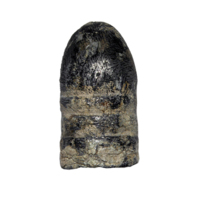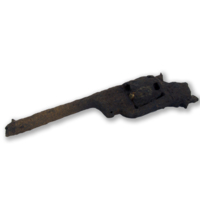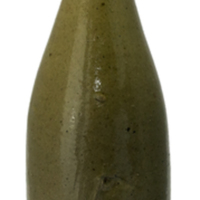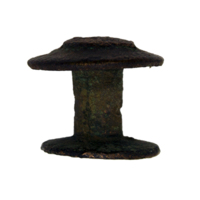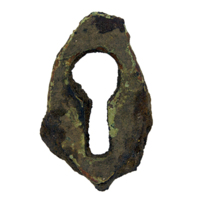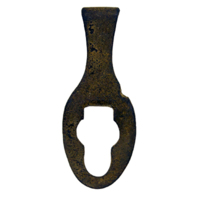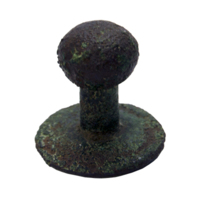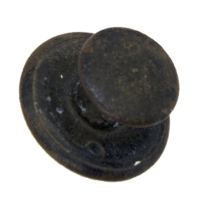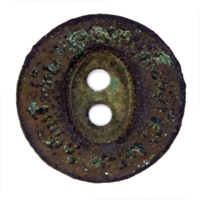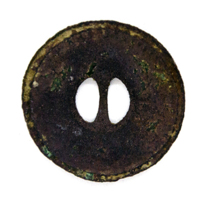The Hodgkinson miners visit Pana Wangal (Trinity Bay)
By September 1876 there were two parties out looking for a track from Thornborough to the coast at Pana Wangal (Trinity Bay), one led by bushman Bill Smith, the other by Sub-Inspector Douglas. On 21 September 1876, Bill Smith and his party of bushmen and Aboriginal guides arrived in Thornborough and announced they had found a track to coast. The news was met with great excitement and copious celebratory toasts of Jas. Hennesy brandy.
The miners take a trip to the coast
The advancing dry season meant there was little water or feed available for the animals and so the pace of work at the gold mines and stamper batteries on the Hodgkinson had slowed. Many of the miners were at a loose end and were keen to see Smith’s Track and the site of the new port at Trinity Inlet. They pestered Smith to show them the way. Surrounded by impatient miners, Smith decided not to wait for Goldfields Warden Mowbray, who was expecting news from Douglas’ party, and so, on 25 September 1876, Smith set off for the coast along Smith’s Track, accompanied by a group of around 160 miners. Smith intended securing a block of land at the new port settlement, while his travelling companions thought they were “on their way to fortune in some shape, but of what kind they had not the most remote idea”.1 They planned to occupy the prime business sites at the new port and then when the expected rush of wealthy southern speculators arrived they would have to give fancy prices for residences or other squattages.
Two days later, Douglas’ two Aboriginal troopers arrived in Thornborough. They informed Mowbray that Douglas had cut a fine road to the coast and was waiting for them at Trinity Inlet. The following morning Mowbray left Thornborough for Trinity Inlet. The two troopers led the way and they were accompanied by Mulligan, John Jones Byers, Sub-Inspector Robert Little, Edward Montague Geary, Messrs. Parker and Sharpe, and yet another large group of miners who were keen to see Douglas’ Track. They made around 25 miles before camping for the night. Just before halting they met up with some of the stragglers from Smith’s group, who were struggling with the weight of the picks and shovels they were carrying and hampered by blisters and sore feet.2 The men were carrying their heavy tools because they believed the government would pay them 15 shillings a day to make improvements on the steeper sections of Smith’s Track.
On 29 September 1876, Mowbray’s party camped at Groves Creek near the top of the range, and the next day they made their way down the steep pinches on Douglas’ Track, swearing, slipping and blowing.3 The travellers were not impressed with Douglas’ Track and came to the conclusion that if this was to be the dray track, and Smith’s Track was no better, then “Trinity Bay would remain in possession of its usual inhabitants for all times”. Upon arriving at Trinity Inlet, Mowbray’s party met Douglas, his two surveyors and the police party of Aboriginal troopers under Constable McDermott. They were with the party despatched from Cardwell under harbor pilot, Edward W. Brittain, which included Sub-Inspectors Robert Arthur Johnstone and George Townsend, Corporal Mowbray and nine Aboriginal police troopers.4 The miners had no hesitation informing Douglas and the government party of their disappointment at the condition of the track. It would seem that getting a dray road to the coast at Trinity Inlet would be a difficult proposition.5
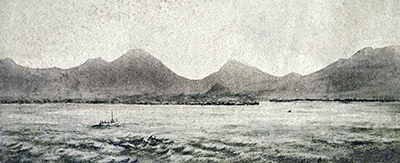
P. Dodgson, Drawing of Trinity Bay, Queensland, 1876.
Image number: 45979, picqld-2003-03-17-11-31
John Oxley Library, State Library of Queensland.
Two camps at Trinity Bay
Smith and the miners that had followed him from Thornborough camped at Smith’s Landing on Smith’s Creek (today’s suburb of Portsmith). This was the only accessible deep-water anchorage in the area and Smith thought it was an ideal place for the new Trinity Bay settlement. Six years earlier, Smith’s Creek had been a site of conflict between the Gimuy Walubara Yidinji people and Bêche-de-mer fisherman Phil Garland, who attempted to steal a canoe. The place was sometimes referred to as ‘Battle Camp’ or ‘Battle Creek’.6
Douglas and Mowbray camped at the white sandy beach at the southern end of Trouton Esplanade, which had been named by Police Magistrate Brinsley Guise Sheridan during a visit to Trinity Bay two months earlier.7 Douglas thought this would be the best site for a new settlement. The two parties waited for the government surveyor to arrive from Cardwell.
| Go to the next section ⇒ The Establishment of Cairns. | |
 |
This webpage is an excerpt from the upcoming book Old Smithfield: Barron River township (1876-1879) by Dr Dave Phoenix. Find Out More Here |
Featured Artefacts from Old Smithfield:
-
1. Port Denison Times, 14 October 1876, D2301, Cairns Historical Society. ↩
-
2. Port Denison Times, 14 October 1876, D2301, Cairns Historical Society. ↩
-
3. Port Denison Times, 14 October 1876, D2301, Cairns Historical Society. ↩
-
4. Port Denison Times, 14 October 1876, D2301, Cairns Historical Society. ↩
-
5. Capricornian (Rockhampton), 21 October 1876: 685. ↩
-
6. Dorothy Jones, Trinity phoenix : a history of Cairns and district (Cairns : Cairns and District Centenary Committee, 1976): 16; Queenslander, 19 March 1904: 2; 3 December 1904: 8. ↩
-
7. Captain Frederick Henry Trouton (1826-1896) was the General Manager of the Australasian Steam Navigation Co. ↩


